UNITED STATES—The terminology has certainly changed over the years. Not many of us remember what tree surgeons were, or that there were actually a few different kinds of tree surgeons, who performed very distinct tasks. Tree surgeons are now known as ‘arborists.’ Much of what they used to do is done by other types of horticultural professionals. The work that arborists still perform is ‘arboriculture.’
Back when orchards were still common in the Santa Clara Valley, Orange County, and many of the areas of California that are now urban, those who pruned deciduous fruit trees while dormant in winter were known as tree surgeons. Of course, they did other work that the trees needed through the rest of the year, and harvested fruit as well. They might be known as orchardists nowadays.
Tree surgeons also assembled new orchards, as well as individual trees in home gardens. It used to be standard procedure to install the understock of fruit trees in the first winter, and let it grow through the following year. A tree surgeon would return while it was dormant the following winter, to graft desired scions onto it. This is now done by nurserymen in nurseries that sell finished trees.
The tree surgeons who we now know as arborists are, of course, still important. The tree surgery that we now know as arboriculture is the sort or work that other horticultural professionals are not qualified or able to perform. It involves the biggest of trees that are out of reach from the ground, or even from ladders. There are still a few different kinds of arborists, but most must climb trees.
Arboriculture is the horticulture of trees. Arborists are therefore horticulturists of trees. Those who are certified with the International Society of Arboriculture, or ISA, have passed an examination of their arboricultural expertise, and maintain their credential by continued involvement with the educational seminars, classes and workshops of the ISA. Arborist can assess the health, stability and structural integrity of trees, and prescribe and supervise necessary corrective arboricultural procedures.
Highlight: cottonwood
Several native species and varieties of poplar are known collectively as cottonwood. Not many are actually planted. They just have a sneaky way of appearing in well watered parts of the garden that are as damp as the riparian areas that they naturally inhabit. Only Fremont cottonwood, Populus fremontii, gets planted, rarely, and only in big spaces that can accommodate its grand scale.
Although too big and too thirsty for most refined landscapes, cottonwoods work well for shade or erosion control in big parks. However, they need to be in a lawn or irrigated landscape if they are not close enough to riparian areas to disperse their roots into soil that is somewhat moist through most of the year. Even in riparian situations, young trees need irrigation until their roots disperse.
Cottonwoods grow fast and big, with aggressive and potentially destructive roots. They should not be planted too close to pavement or septic systems. Vigorous trees might sometimes need to be pruned to reduce excessive weight. Big trees might grow to nearly a hundred feet tall, with wide canopies. Bark is handsomely furrowed with age. The deciduous foliage turns yellow in autumn.
Horticulturist Tony Tomeo can be contacted at tonytomeo.com.






